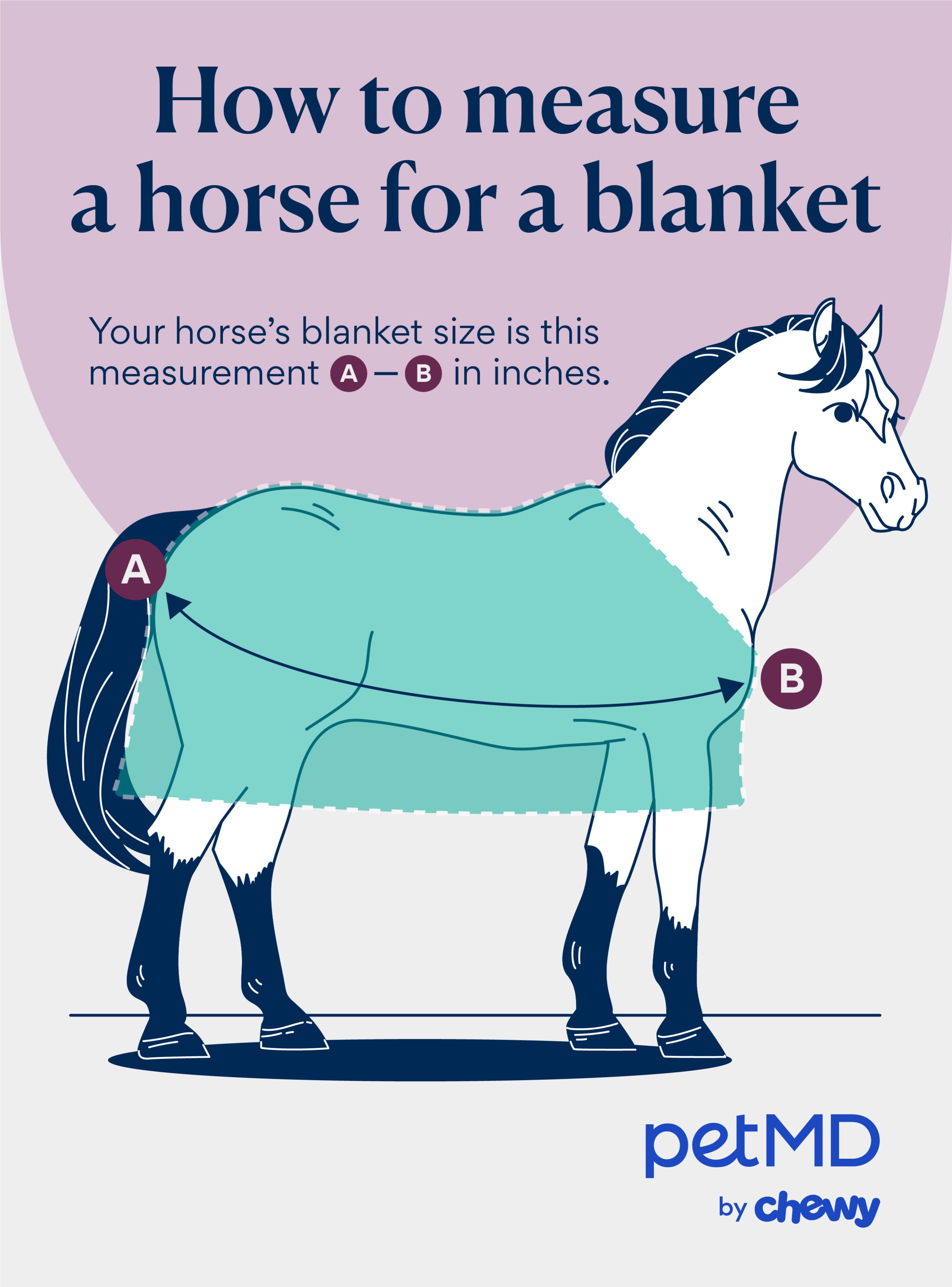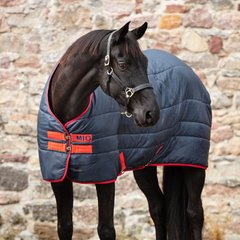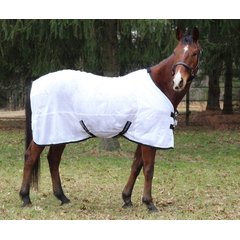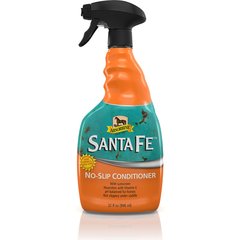How To Measure a Horse for a Horse Blanket
Sheikoevgeniya/iStock / Getty Images Plus via Getty Images
Whether you’re blanketing your horse to offer fly protection in the summer, to provide warmth in winter, or to help keep him clean before a show, purchasing a properly sized blanket is essential. Knowing how to measure a horse for a blanket can help you order the right size the first time.
Why Are Horse Blankets Important?
Before measuring a horse for a blanket, it’s helpful to understand the different types of blankets available. These are four common horse blanket types:
-
Stable blankets are used on stalled horses, as they are not waterproof.
-
Turnout blankets are more rugged, waterproof, and designed for outdoor use.
-
Coolers, usually made of fleece or wool, are used after exercise to wick away sweat and help the horse cool down gradually.
-
Fly sheets are made of a mesh fabric to protect the horse from insects.
Healthy horses that grow a thick winter coat and have access to a shelter are naturally designed to handle cold winter temperatures without a blanket. However, there are several situations when you may need to blanket your horse.
-
You have a hard keeper. An extra layer of insulation from a blanket means they’ll burn fewer calories trying to stay warm.
-
You have a senior horse. Some older horses may not grow as thick a coat and have a harder time keeping warm due to age.
-
You ride regularly. Horses that stay in work year-round are body-clipped, and a blanket compensates for the lack of hair.
-
You want to keep horses clean. A blanket can make the grooming routine easier before a show and during wet, muddy conditions.
Recommended Products
How To Measure a Horse for a Blanket
Outfitting your horse in the correctly sized blanket is important for his safety. A blanket that is too big can shift out of place, and a blanket that is too tight can rub on the shoulders, withers, and legs, creating bald spots or worse—sores.
Horse blanket sizes are measured in inches or centimeters, indicating the length from the center of the horse's chest to the hindquarters. Every blanket brand should have the best guidelines to follow for measurements of your horse, and following these steps will help you know how to generally size a horse blanket:
-
Make sure your horse is standing squarely on even ground.
-
Place the end of a flexible measuring tape at the center point of the horse’s chest just below the base of the neck.
-
Stretch the tape alongside the horse’s body to the center of the horse’s tail.
-
Record the measurement, which equates to the size your horse needs.
If your horse is in between sizes, choose the next size larger. Some brands run a little large or a little small, so look at the customer reviews from other horse owners who have purchased the same blanket.

Horse Blanket Size
Consider your horse's build, including the width of his chest and back length. A stocky or bulky horse will need a different fit than a more slender-built breed. Blankets come in a variety of cuts, such as V-front closures, cutbacks, and darts at the shoulder designed to fit different conformation styles.
Look for blankets with adjustable straps and gussets; these features can help customize the fit and provide better comfort for your horse. A well-fitted blanket hangs just below the horse’s elbows and stifles.
Every horse is an individual, so knowing how to measure your horse for a blanket will give you the most accurate size.
Horse Blanket Fill
Blanket fill (measured in grams) or weight is equally important to consider.
Horses can better regulate their temperature than humans. When they are healthy, have time to acclimate to weather changes, grow a coat, and have a place to get out of the wind and wet conditions, they can withstand zero temperatures and even sub-zero temperatures.
Therefore, choosing a blanket with too much insulation can make the horse sweat, which sets up the perfect environment for skin infections. Skipping a thorough cool-down routine and blanketing a damp horse also creates conditions for skin infections to start.
Before selecting the coziest-looking blanket, consider your horse’s health and living conditions. An unlined sheet may be all he needs if he is healthy and cleanliness is your primary goal.
|
Blanket Weight |
Description |
How This Compares to Human Jackets |
|
Unlined |
No insulation |
A raincoat |
|
Light Weight |
100–180 g fill |
A sweatshirt |
|
Mid Weight |
150–280 g fill |
A lined jacket |
|
Heavy Weight |
300–400 g fill |
A ski jacket |
|
Ultra Heavy Weight |
400+ g fill |
Arctic gear |
Horse Blanket Denier
You’ll also notice that blanket makers include a “D,” which stands for denier. Denier denotes the nylon fiber density and rates the durability of the blanket’s outer shell.
Like fill weight, denier varies. A higher denier, like 1200D+, indicates the blanket is more durable and more water-resistant than a lower denier, like 600D.
How To Put on a Horse Blanket
Following these steps will help you correctly dress your horse while keeping him calm and ensuring proper fit.
-
Fold the blanket into thirds so the inside lining faces outward if the front opens completely. Otherwise, the blanket may need to be put on over the horse’s head.
-
Allow the horse time to sniff the blanket.
-
Gently place it on his back near the withers.
-
Unfold the front of the blanket first and then the back.
-
Buckle or snap the front closures and shift the blanket into place so that it is resting against the horse’s chest.
-
Turn any snaps inward toward the horse’s chest to reduce the chances of getting snagged on a fence, hay net, hay feeders—and yes, even another horse during play.
-
With caution, reach for the belly straps or surcingle and buckle them.
-
Adjust the length of the belly straps or surcingle so that there is enough room to slip your hand between the straps and your horse, but tight enough that the straps do not hang haphazardly low.
-
Carefully reach for the leg straps and secure the first one in place, which should go through the horse’s back legs and secure to the opposite side on a diagonal.
-
Grab the second strap over the first and secure on the opposite side.
Choose blankets with elastic leg straps. These easily break should a horse snag a leg or fence.
If the blanket has only one strap at the back of the blanket, it should go under the horse’s tail to prevent the back of the blanket from blowing up and over the horse’s back.
Tips for Blanketing a Nervous Horse
If your horse is nervous about blanketing, opt for an open-front blanket that features buckles or snap closures. Closed-front blankets are solid and must be lifted up and over the horse’s head.
Ask an experienced horse handler to help hold the horse while you blanket. Stand in a position where you can’t be bitten or kicked if the horse reacts.
If the horse is truly stressed or becomes dangerous, stop. It may require several sessions of introducing a blanket without fully securing it to help a horse become comfortable with blanketing.
Caution: Do not turn a horse out wearing a blanket without using back leg straps or a butt strap. Wind and horseplay can quickly flip the butt end up over their head and neck. In a worst-case scenario, this can spook a horse and result in injury.
Additional Blanketing Tips
Blankets are an investment and require regular washing and repair to keep your horse healthy and warm. With these additional tips you can prolong the lifespan of your horse blankets.
-
Reapply a waterproofer to turnout blankets at the start of each year. You can do this yourself or pay for a service.
-
Switch blankets when they are dirty. Wash them with a detergent-free wash that is safe for animals before putting it back on a horse.
-
Repair blankets when they have rips and tears and replace them when the wear and tear become significant.
And—for your horse’s comfort, spray on a coat conditioner to reduce static buildup. Use a non-slip product to avoid saddle slippage.
Recommended Products



